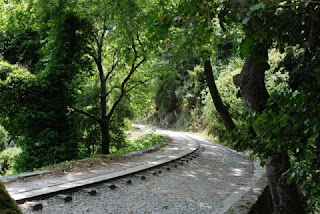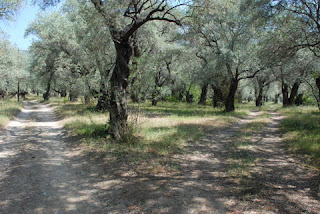



We drove to Makedonia (Thessaloniki) Airport and parked in the long term car park as planned, arriving in plenty of time for the flight. The Easyjet plane left on time, was not full and arrived more than 20 minutes early, making for a very pleasant flight. The Europcar car was a Skoda Fabia with only 350 miles on the clock – at £20 per day (through Easyjet) it was a bargain. However, when we arrived at the desk, we were told that there was a £600 excess for any damage but we could reduce this to £100 if we paid an extra £6.50 per day or remove the excess totally for £12.50 per day. This is an excellent example of keeping the headline figure low whilst trying to increase profits on 'extras'. We didn't fall for the trick but I did drive carefully for the next six days! There was a fuel tanker driver strike threatened for the weekend so we opted to purchase the tank of fuel (at, surprisingly much less per litre than the current pump prices) and then return the car empty. This is also a profit-making move as most people don't drive very far and therefore leave a lot of fuel in the tank. I was delighted to be able to return the car with the 'reserve tank' warning light on!
I know that it is a cliché, but England did look wonderfully green as we landed at Gatwick and the journey back was delightful once we left the motorways and headed down the A303 towards Somerset. Stonehenge, often an area of huge traffic jams, was no problem although there were large warning signs for delays over the coming weekend, Summer Solstice, when Druids and other strange people descend on the stones. And then we arrived back in the lovely Somerset countryside and our beloved village. Dinner was purchased from the local village shop and the work began. There was much dusting, hoovering and general cleaning to be done in the house and the gardening would have to wait until tomorrow.
Tomorrow (Wednesday) dawned but before starting the gardening, I had some other necessary visits planned. Pete the barber recognised me despite the long hair and earned his very modest fee by cutting most of it off whilst keeping up an entertaining conversation. Then, with trepidation, I went to the dentist to see what he would make of my disintegrated tooth. I was lucky that, despite the fact that I had lost a piece of the tooth and many pieces of filling over the last six weeks, I hadn't had toothache. However, I had been warned many years ago by a previous dentist that I was likely to lose the tooth in the future and expected this to be the time. When our Polish dentist first arrived from Poland, his English was poor and his lack of communication often gave people the idea that he was brusque. However his English is now good and it is easy to have a conversation with him. To my delight, he told me that he would be able to save the tooth and fill it without the need for anaesthetic, although I had more filling put in the tooth than with any other filling that I have ever had. The rest of the day was spent around the house, updating software on both computers and gardening, including weeding and removing of that awful Lemon Balm plant that spreads everywhere. Our next door neighbours, Anthony and Jude very kindly mow the small lawn for us and we are very grateful that we didn't come back to waist-high grass! Jude has also adopted part of the vegetable patch and her courgettes, kale, beans and onions were coming on well.
Thursday was spent visiting my mother and Jane's parents in Weymouth. It was great to see Jane's mum recovered from her broken wrist and much more cheerful than during that traumatic time. We took my mother out in the car to Abbotsbury and parked the car in a lay-by with a wonderful view of Chesil Beach, the Fleet (known as the Little Sea to the locals – a small stretch of water between Chesil Beach and the mainland) and over to the Isle of Portland. Dorset is a beautiful county and this sea view and the views inland are some of its best. We popped to see my brother and sister-in-law and exchanged news since our meeting in Skopelos and, after picking our our mountain of redirected post from them, we headed home.
Friday was Jane's turn for a haircut (or rather a hairdresser's appointment) and a visit to the dentist. Jane had cracked a tooth just a few days before we returned and was lucky to be able to get this appointment at short notice. She had, for her, a very rare filling and, like me, did not have to have anaesthetic – perhaps this is the latest fashion? Meanwhile, with rain promised later in the day, I was attacking the hedge between our and Anthony and Jude's gardens. I managed to complete that, cut the beach hedge on the other side and severely prune the vines growing on two walls before the rain started. Anthony and Jude had invited us over for a meal and we had a lovely relaxed meal chatting with them. They have also bought a motorhome and much of the time was spent talking about their plans and our experiences.
Saturday we visited parents in Weymouth again before setting off for the Cotswolds and joining, briefly, the BAGS Packed weekend. BAGS is an informal village walking group that I formed many years ago. There are walks planned every month and the BAGS Packed weekend is an extension of this where the group head off to a walking area for the weekend, walking each day and staying in a small hotel. We had deliberately planned our return trip to England to coincide with this weekend but couldn't be sure that we would be able to join them. However, closer to the time and once we had booked our hire car, we knew that we would be able to go. Our friend Ann had managed, with difficulty, to find us a place for the Saturday night in a B&B close to their hotel in Bourton in the Water. This meant that we could join them for an evening meal and walk with them on the Sunday morning. It was great to be with the group, which consists of most of our closest friends and the evening was spent catching up with news from all of them.
The walk on Sunday was excellent. Although we had a little rain whilst we were enjoying our full English breakfast, that was the last rain that we saw that day. The walk was a circular one from the pretty and much visited village of Bibury, six flat miles in beautiful green countryside watered by picturesque streams and with many traditional Cotswold houses. The landscape was painted, leopard style with spots of shade from the small, white clouds that were scurrying across the blue sky on the very strong wind. We were lucky with the weather as the group got very wet on their Friday walk and the Saturday walk had started with drizzle. However this was much better than the forecast that I had seen earlier in the week that showed Friday, Saturday and Sunday as heavy rain, rain and heavy rain respectively! After lunch at a hotel in Bibury, we all said goodbye, the rest of the group heading home and us heading off to Bracknell to see Simon and Katie.
It was another easy journey and we arrived shortly before 17:00. Katie was doing her voluntary work at Whipsnade Zoo but arrived home shortly afterwards. The evening was spent in great company with great food. Simon told us lots of things that he thought that he had already told us but hadn't and we were able to see pictures of the new house that they are renting in Ascot from August. Katie is still enjoying her job and we are keeping our fingers crossed for the results of her latest round of CIMA accounting exams.
Photos: The river in the centre of Bourton in the Water; The BAGS at Bibury; There are plenty of footpaths on the Cotswolds but sometimes it is difficult to decide which one to take!; These sheep took an interest in our passing – it seemed strange to see sheep without an accompanying shepherd.

















































